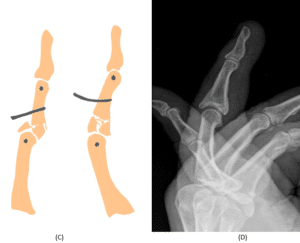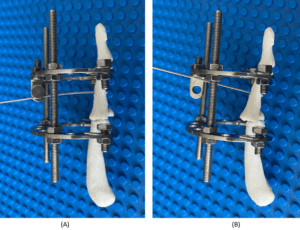Alexander S Zolotov1*
1Department of Orthopedic Surgery, Medical Center, Far Eastern Federal University, Campus, 10 Ajax Bay, Russky Island, Vladivostok 690922, Russia
*Correspondence author: Alexander S Zolotov, Department of Orthopedic Surgery, Medical Center, Far Eastern Federal University, Campus, 10 Ajax Bay, Russky Island, Vladivostok 690922, Russia; Email: [email protected]
Published Date: 29-01-2024
Copyright© 2024 by Zolotov AS. All rights reserved. This is an open access article distributed under the terms of the Creative Commons Attribution License, which permits unrestricted use, distribution, and reproduction in any medium, provided the original author and source are credited.
Abstract
The treatment of complex intra-articular fractures of the middle phalanx is a difficult task for the hand surgeon. A 61-year-old male presented with complex intra-articular middle phalanx fracture of the ring finger which was treated with the aid of the Ilizarov mini-apparatus. The proposed use of the Ilizarov mini-apparatus has some advantages. The degree of traction is easy to dose and control. Parts of apparatus and K-wires do not cover the image of the proximal interphalangeal joint on radiographs. The Ilizarov mini-apparatus is quite stable.
Keywords: Proximal Interphalangeal Joint Injuries; Middle Phalanx; Pilon Fracture; Ex-Fix; Mini-Ilizarov; Pins Traction System
Level of Evidence IV
Introduction
The treatment of complex intra-articular fractures of the middle phalanx is a difficult task for the hand surgeon. Many surgeons use external fixation devices and various traction systems in the treatment of pilon fractures, which make it possible to eliminate gross displacement and begin early movements in the damaged joint [1-7]. Each external fixator has its own advantages and disadvantages. Unfortunately, there is no ideal. As an alternative and addition to existing methods, the authors propose the use of the Ilizarov mini-apparatus.
Case Report
A 61-year-old male presented with a multi-comminuted intra-articular fracture of the ring finger middle phalanx of the left hand (Fig. 1). He applied on the 4th day after trauma (fall on his hand). Under regional anesthesia, a mini-Ilizarov apparatus was assembled on two arches. The beginning of assembly of the device is similar to application of the Suzuki fixator. The first K-wire (1 mm in diameter) is inserted into the frontal plane through the head of the proximal phalanx, the second – through the head of the middle phalanx. The K-wires are fixed in the arcs of the apparatus with the aid of bolts with holes (or splits) and nuts. The arcs are connected by threaded rods. With the help of distraction along the threaded rods, displacement along the length was eliminated. The third K-wire is inserted in the sagittal plane at the level of the diaphysis of the middle phalanx at an angle from the dorsal to the palmar in the distal direction through two bone’s cortices. The free end of the wire was deflected to the distal arcs. After elimination of the displacement, the free end was fixed with tension to the cantilever attachment. We slightly modified the standard K-wire’s bolt-fixator on the proximal arch; the height of the bolt head was reduced from 4.2 mm to 2.8 mm so that the K-wire’s bolt-fixator did not cover the image of the joint on the lateral radiograph. In the postoperative period, the patient performed careful active and passive movements of the finger joints. The period of fixation in the apparatus was 6 weeks. After removing the device, the patient underwent rehabilitation with a hand therapist. Two years after the injury there was no pain, flexion (PIPJ) 70 degrees with deficiency of extension 5 degrees. The grip strength is 48 kg on a left hand (54 kg on a healthy hand). In the control radiographs the fracture had healed with moderate signs of arthrosis of the PIP joint.
Discussion
It is not always possible to restore the anatomy and achieve stable fixation even when performing open reduction. Surgical treatment is associated with a high risk of complications and functional impairment. Many surgeons use external fixation devices and various traction systems when treating pilon fractures, which make it possible to eliminate gross displacement and begin early movements in the damaged joint. Complete reduction is not possible in all cases, but early movements are of great importance in restoring function. Each external fixator has its own advantages and disadvantages. The same applies to traction systems. What matters is the stability of the fixation, its controllability, the functionality of the fixator and the “transparency” of its parts for X-rays. For example, external fixation devices can obscure the image of bones and joints on radiographs and some of them are only static and do not allow movement in the proximal interphalangeal joint [4,6].
A very popular traction system among surgeons is the pins and rubbers traction system proposed by Suzuki in the original version and in various modifications [1,2]. However, this fixator has some disadvantages: 1 – it is difficult to dose and control the required degree of traction; 2 – in some cases, the axial K-wire on the lateral radiograph covers the fracture line; 3 – the Suzuki system is not stable enough in the frontal plane, therefore smooth K-wires can move and rest against the skin of the finger. Traction systems are inferior in stability to external fixation devices.
The proposed use of the Ilizarov mini-apparatus has some advantages over pin traction systems and other Ex-Fix apparatus. The degree of traction is easy to dose and control. Parts of the apparatus and K-wires do not cover the image of the proximal interphalangeal joint on radiographs. The Ilizarov mini apparatus is more stable than the Suzuki fixator and modifications. The standard set permits the assembly of an apparatus for fixation of bone fragments, reposition, distraction or compression. In our case a mini frame, assembled from a few details, allowed us to do distraction, reposition and stable fixation for the entire period of treatment. The Ilizarov apparatus is certainly inferior in terms of cost and availability compared to pin traction systems. A set of details for this complex costs about $50 US. However, if different fixators are available to the surgeon, one may consider using the proposed layout. Most external fixation devices are original and proprietary and therefore inaccessible. The Ilizarov mini-apparatus is mass-produced.
The functional result of the treatment in our case is not ideal. Probably, it is connected with the severe injury and defect of the joint surface. Completely reconstructing the anatomy in this particular case is a difficult task. Open reduction and internal fixation is associated with a risk of complications and not always the desired result. The minimally invasive technique we chose made it possible to eliminate deformity, fix the fracture stably and allowed passive and active movements in the PIP joint to begin just after the surgery.
A priori, the proposed device option may be useful in the treatment of palmar and dorsal fracture-dislocations in the proximal interphalangeal joint. With a dorsal displacement of the middle phalanx, the third K-wire should be inserted and then bent in the opposite direction (Fig. 2). This K-wire serves not only for repositioning, but it also ensures the stability of the device in the frontal plane.


Figure 1: Photo and radiographs of the hand of a 61-year-old patient. A: lateral radiograph after injury; B: lateral radiograph after surgery; С: drawing illustrating the lever-assisted reduction of a fracture; D: lateral radiograph 2 years post op.
Figure 2: The proposed method of assembling the apparatus on a bone model. The third K-wire is inserted in the sagittal plane at the level of the diaphysis of the middle phalanx at an angle from the dorsal to the palmar in the proximal direction through two bone’s cortices
Conclusion
In conclusion, the Ilizarov mini-apparatus can be an alternative and addition to the traditional external fixators and pin traction systems for the treatment of complex intra-articular fractures of the middle phalanx.
Conflict of Interests
The author has no conflict of interest to declare.
References
- Agee JM. Unstable fracture dislocations of the proximal interphalangeal joint. Treatment with the force couple splint. Clin Orthop Relat Res. 1987;(214):101-12.
- Suzuki Y, Matsunaga T, Sato S, Yokoi T. The pins and rubbers traction system for treatment of comminuted intraarticular fractures and fracture-dislocations in the hand. J Hand Surg Br. 1994;19(1):98-107.
- Mizuseki T, Tsuge K, Ikuta Y. Distraction arthrolysis for PIP joint contracture using an external fixator. Tech Hand Up Extrem Surg. 1999;3(1):58-65.
- Margić K. External fixation of closed metacarpal and phalangeal fractures of digits. A prospective study of one hundred consecutive patients. J Hand Surg Br. 2006;31(1):30-40.
- Chauhan A, Sikora-Klak J, Abrams R. Dynamic “homemade” digital external fixators for proximal interphalangeal joint injuries. J Hand Surg Am. 2018;43(9):875.e1-875.e12.
- Kodama A, Sunagawa T, Nakashima Y, Shinomiya R, Hayashi Y, Ochi M, et al. Joint distraction and early mobilization using a new dynamic external finger fixator for the treatment of fracture-dislocations of the proximal interphalangeal joint. J Orthop Sci. 2018;23(6):959-66.
- Mabvuure NT, Pinto-Lopes R, Sierakowski A. Management of intraarticular proximal interphalangeal joint fracture-dislocations and pilon fractures with the Ligamentotaxor® device. Arch Orthop Trauma Surg. 2020;140(8):1133-41.
- Ruland RT, Hogan CJ, Cannon DL, Slade JF. Use of dynamic distraction external fixation for unstable fracture-dislocations of the proximal interphalangeal joint. J Hand Surg Am. 2008;33(1):19-25.
Article Type
Research Article
Publication History
Accepted Date: 31-12-2023
Accepted Date: 22-01-2024
Published Date: 29-01-2024
Copyright© 2024 by Zolotov AS. All rights reserved. This is an open access article distributed under the terms of the Creative Commons Attribution License, which permits unrestricted use, distribution, and reproduction in any medium, provided the original author and source are credited.
Citation: Zolotov AS. Pilon Fracture of the Middle Phalanx: Treatment Using Mini-Ilizarov Apparatus. J Ortho Sci Res. 2024;5(1):1-5.


Figure 1: Photo and radiographs of the hand of a 61-year-old patient. A: lateral radiograph after injury; B: lateral radiograph after surgery; С: drawing illustrating the lever-assisted reduction of a fracture; D: lateral radiograph 2 years post op.
Figure 2: The proposed method of assembling the apparatus on a bone model. The third K-wire is inserted in the sagittal plane at the level of the diaphysis of the middle phalanx at an angle from the dorsal to the palmar in the proximal direction through two bone’s cortices


